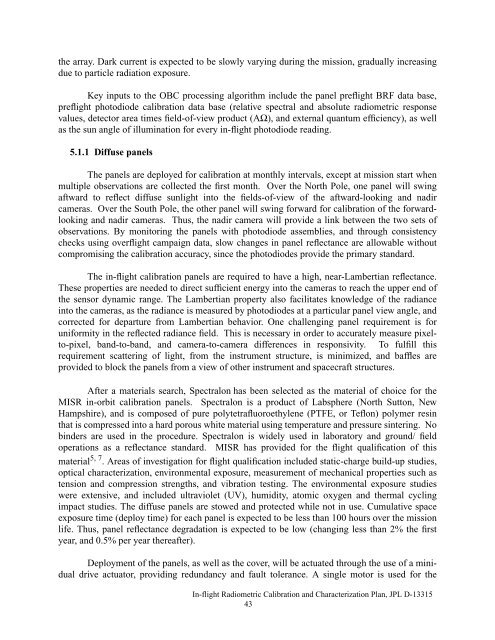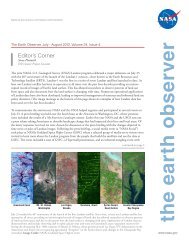MISR: In-Flight Radiometric Calibration and Characterization Plan
MISR: In-Flight Radiometric Calibration and Characterization Plan
MISR: In-Flight Radiometric Calibration and Characterization Plan
Create successful ePaper yourself
Turn your PDF publications into a flip-book with our unique Google optimized e-Paper software.
the array. Dark current is expected to be slowly varying during the mission, gradually increasingdue to particle radiation exposure.Key inputs to the OBC processing algorithm include the panel preflight BRF data base,preflight photodiode calibration data base (relative spectral <strong>and</strong> absolute radiometric responsevalues, detector area times field-of-view product (AΩ), <strong>and</strong> external quantum efficiency), as wellas the sun angle of illumination for every in-flight photodiode reading.5.1.1 Diffuse panelsThe panels are deployed for calibration at monthly intervals, except at mission start whenmultiple observations are collected the first month. Over the North Pole, one panel will swingaftward to reflect diffuse sunlight into the fields-of-view of the aftward-looking <strong>and</strong> nadircameras. Over the South Pole, the other panel will swing forward for calibration of the forwardlooking<strong>and</strong> nadir cameras. Thus, the nadir camera will provide a link between the two sets ofobservations. By monitoring the panels with photodiode assemblies, <strong>and</strong> through consistencychecks using overflight campaign data, slow changes in panel reflectance are allowable withoutcompromising the calibration accuracy, since the photodiodes provide the primary st<strong>and</strong>ard.The in-flight calibration panels are required to have a high, near-Lambertian reflectance.These properties are needed to direct sufficient energy into the cameras to reach the upper end ofthe sensor dynamic range. The Lambertian property also facilitates knowledge of the radianceinto the cameras, as the radiance is measured by photodiodes at a particular panel view angle, <strong>and</strong>corrected for departure from Lambertian behavior. One challenging panel requirement is foruniformity in the reflected radiance field. This is necessary in order to accurately measure pixelto-pixel,b<strong>and</strong>-to-b<strong>and</strong>, <strong>and</strong> camera-to-camera differences in responsivity. To fulfill thisrequirement scattering of light, from the instrument structure, is minimized, <strong>and</strong> baffles areprovided to block the panels from a view of other instrument <strong>and</strong> spacecraft structures.After a materials search, Spectralon has been selected as the material of choice for the<strong>MISR</strong> in-orbit calibration panels. Spectralon is a product of Labsphere (North Sutton, NewHampshire), <strong>and</strong> is composed of pure polytetrafluoroethylene (PTFE, or Teflon) polymer resinthat is compressed into a hard porous white material using temperature <strong>and</strong> pressure sintering. Nobinders are used in the procedure. Spectralon is widely used in laboratory <strong>and</strong> ground/ fieldoperations as a reflectance st<strong>and</strong>ard. <strong>MISR</strong> has provided for the flight qualification of thismaterial 5, 7 . Areas of investigation for flight qualification included static-charge build-up studies,optical characterization, environmental exposure, measurement of mechanical properties such astension <strong>and</strong> compression strengths, <strong>and</strong> vibration testing. The environmental exposure studieswere extensive, <strong>and</strong> included ultraviolet (UV), humidity, atomic oxygen <strong>and</strong> thermal cyclingimpact studies. The diffuse panels are stowed <strong>and</strong> protected while not in use. Cumulative spaceexposure time (deploy time) for each panel is expected to be less than 100 hours over the missionlife. Thus, panel reflectance degradation is expected to be low (changing less than 2% the firstyear, <strong>and</strong> 0.5% per year thereafter).Deployment of the panels, as well as the cover, will be actuated through the use of a minidualdrive actuator, providing redundancy <strong>and</strong> fault tolerance. A single motor is used for the<strong>In</strong>-flight <strong>Radiometric</strong> <strong>Calibration</strong> <strong>and</strong> <strong>Characterization</strong> <strong>Plan</strong>, JPL D-1331543







